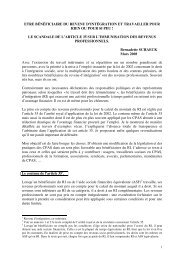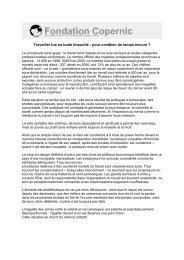Awra Amba RJ 300612 EN - Contacter un comité local d'Attac
Awra Amba RJ 300612 EN - Contacter un comité local d'Attac
Awra Amba RJ 300612 EN - Contacter un comité local d'Attac
Create successful ePaper yourself
Turn your PDF publications into a flip-book with our unique Google optimized e-Paper software.
2. Backgro<strong>un</strong>d history and geographical situation<br />
Figure 3:<br />
Age distribution of the 2005 <strong>Awra</strong> <strong>Amba</strong> population according to data from Atnafu<br />
(2005/32) and of the rural population of the South Gondar zone in 2007 (CSA,<br />
2007/77), and cumulated distributions.<br />
The population increase was interrupted during the exile period (1988-1993), especially because no<br />
marriage happened during these years (At05/33). It appears in Figure 3, where the 10-14 children are<br />
not a lot, compensated by more children yo<strong>un</strong>ger than 10, in comparison to rural population of South<br />
Gondar. The age distribution shows also a quite abrupt decrease after 19 years. Globally, the<br />
population of <strong>Awra</strong> <strong>Amba</strong> contains more children and adults yo<strong>un</strong>ger than 40 than the rural<br />
population of South Gondar, less people between 40 and 70 and a bit more people older than 70.<br />
2.3. Geographical situation<br />
<strong>Awra</strong> <strong>Amba</strong> is a very small comm<strong>un</strong>ity. We place it quickly in the different administrative and<br />
geographical structures, from the biggest, Ethiopia, to the smallest, the comm<strong>un</strong>ity itself, giving<br />
some characteristics of each.<br />
The Federal Democratic Republic of Ethiopia is located in the Horn of Africa (Figure 4). It is a<br />
landlocked co<strong>un</strong>try, bordered by Somalia to the southeast, Sudan to the west, South Sudan to the<br />
southwest, Kenya to the south, Djibouti to the east and Eritrea to the north. The co<strong>un</strong>try has 91<br />
millions of inhabitants and occupies 1 127 000 km 2 , i.e. nearly two times France. Its altitude varies<br />
from -120 m to 4 543 m. It combines high plateaus (especially the central plateau between 1 800 and<br />
3 000 m high), steep mo<strong>un</strong>tains and canyons, volcanic areas, savannah, desert regions and green high<br />
plains. It is a federal republic divided into nine regional states (including Amhara region) and two<br />
chartered cities (the capital city Addis Ababa and Dire Dawa).<br />
From a socio-economic perspective, Ethiopia has a Human development index (which mixes<br />
indicators of national wealth, education and health) among the lowest in the world, but also an<br />
ecological footprint (which mixes indicators of non-renewable energy consumption, greenhouse gas<br />
emission and land take) very low, making it a less developed but very "ecological" co<strong>un</strong>try (see<br />
Figure 5). Yassin (2008/2) emphasizes the increasing pandemics, reducing the workforce needed by<br />
25 / 85

















